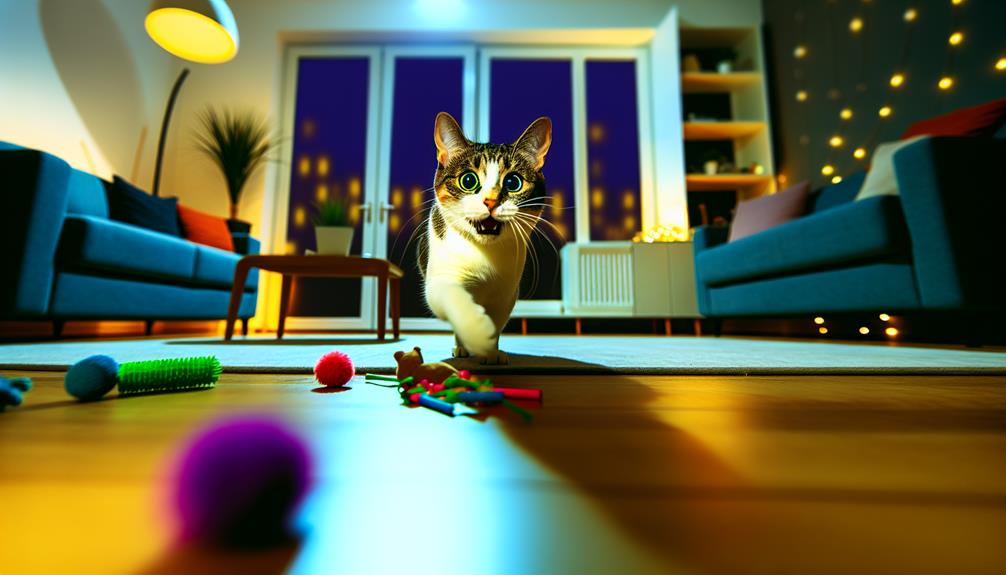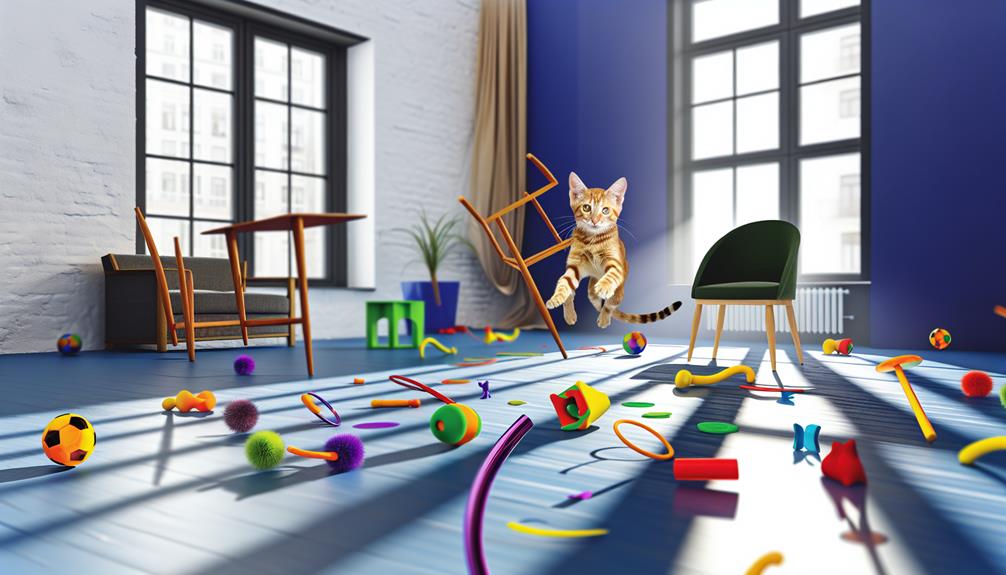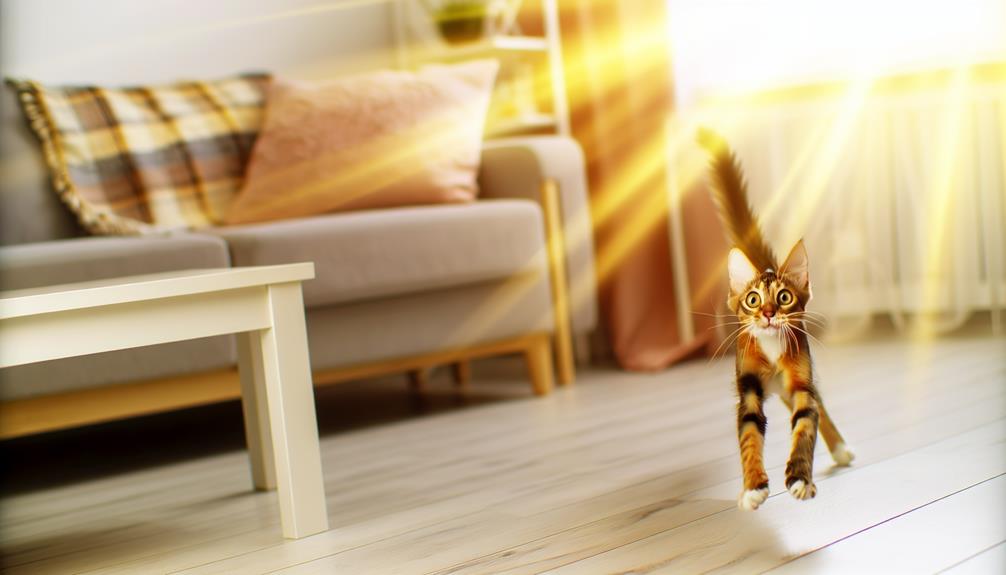Imagine your cat transforming into a whirlwind of fur and chaos, darting around the house like it's auditioning for the feline Olympics. You might wonder what's behind these sudden bursts of energy commonly known as the zoomies. It's more than just random behavior; these antics are deeply rooted in your cat's natural hunting instincts and their crepuscular nature. Factors like accumulated energy, environmental triggers, and even emotional stress play significant roles. Curious about how you can help manage these energetic outbursts and guarantee your cat's well-being? Let's explore further.
Natural Hunting Instincts
A cat's zoomies can be traced back to their natural hunting instincts, which are deeply embedded in their genetics. When your cat suddenly darts around the house, this seemingly erratic behavior is actually a manifestation of their instinctual drives. Cats, both domestic and wild, have evolved as predators. This predatory nature necessitates bursts of energy to catch prey, and these bursts are reflected in the zoomies you observe.
Understanding a cat's hunting behavior is essential. In the wild, cats engage in a cycle of stalking, chasing, and pouncing to secure their next meal. Even though your domestic cat doesn't need to hunt for survival, these behaviors are hardwired into their DNA. When your cat exhibits zoomies, it's mimicking the rapid, unpredictable movements required to catch prey. This activity is not random but a sophisticated display of their ingrained hunting techniques.
Instinctual drives play a significant role in shaping a cat's actions. Zoomies can often be seen as a way for cats to practice their predatory skills. Without the need to hunt for food, these instincts still find an outlet. Though you've provided them with a safe environment and regular meals, their predatory instincts remain intact, prompting these bursts of high-energy activity.
Release of Pent-Up Energy
When your cat experiences a burst of frenetic energy, it's often due to the accumulation of unspent energy from their natural hunting instincts. Without adequate playtime and stimulation, this pent-up energy can manifest as sudden, erratic behavior. Understanding this connection is essential for addressing your cat's needs effectively.
Natural Hunting Instincts
Cats' zoomies, those sudden bursts of high-energy activity, can be traced back to their natural hunting instincts. In the wild, felines rely heavily on their ability to stalk and capture prey. This instinctual drive for hunting is deeply embedded in their DNA, influencing various aspects of feline behavior. When your cat darts around the house, it's not just playful randomness; it's a manifestation of these ingrained survival tactics.
In domestic environments, the opportunities for actual hunting are limited. Consequently, your cat's pent-up energy needs an outlet, resulting in these frenetic episodes. The zoomies are fundamentally a way for your cat to simulate the chase and capture sequences that are crucial in the wild. These high-energy bursts help maintain muscle tone, sharpen reflexes, and keep their minds engaged.
Furthermore, zoomies can be seen as a natural response to the lack of stimulation in a controlled indoor setting. Basically, your cat is mimicking the complex behaviors necessary for survival. Understanding this connection between zoomies and natural hunting instincts provides insight into why these seemingly erratic episodes occur, emphasizing the significance of recognizing and respecting your cat's inherent behavioral needs.
Playtime and Stimulation
Engaging in regular playtime is essential for your cat's well-being, as it provides the necessary stimulation to release pent-up energy. Cats are natural hunters, and in the absence of real prey, they often rely on interactive toys and sensory play to fulfill this instinctual need. Without adequate stimulation, your cat might exhibit the zoomies, or sudden bursts of frenetic energy, which can sometimes be disruptive.
To mitigate this behavior, it's vital to incorporate various forms of play that target different senses and physical activities. Here are some effective strategies:
- Interactive toys: Use feather wands, laser pointers, or motorized toys to engage your cat in chasing and pouncing activities.
- Sensory play: Introduce toys that make noise or have different textures to stimulate your cat's senses.
- Puzzle feeders: These not only provide mental stimulation but also mimic the hunting process, encouraging your cat to "work" for their food.
- Regular play sessions: Schedule multiple short play sessions throughout the day to keep your cat engaged and prevent boredom.
Evening Energy Surges

Despite being nocturnal by nature, cats often experience evening energy surges, commonly referred to as the "zoomies," which can leave many pet owners baffled. Understanding this phenomenon requires a deeper examination of feline instincts and nocturnal behavior. Cats are crepuscular animals, meaning they are most active during dawn and dusk. This trait is deeply rooted in their wild ancestors, who hunted during these low-light periods to avoid larger predators and maximize hunting success.
In your household, evening zoomies are a manifestation of these ingrained behaviors. During the day, a domestic cat may spend significant amounts of time resting, conserving energy for those twilight hours when their instincts kick in. As evening approaches, your cat's internal clock signals that it's time to engage in physical activity, mimicking the hunting and territorial behaviors of their wild counterparts.
Moreover, evening energy surges are also linked to the pent-up energy accumulated throughout the day. If your cat hasn't had enough stimulation or playtime, they are likely to release this stored energy in short, intense bursts. These bursts often involve rapid running, sudden changes in direction, and playful pouncing, all of which are reminiscent of hunting and stalking prey.
It's crucial to provide opportunities for your cat to exercise and engage with their environment, especially as evening approaches. Interactive toys, climbing structures, and designated playtimes can help channel this energy more constructively. By aligning your cat's activities with their natural rhythms, you can mitigate the seemingly chaotic behavior and guarantee a more harmonious living environment for both you and your feline companion.
Response to Stress
When your cat experiences environmental triggers, such as loud noises or sudden changes, it may exhibit zoomies as a form of emotional release. This behavior often serves as an outlet for pent-up energy accumulated during stressful situations. Understanding these responses can help you identify and mitigate potential stressors in your cat's environment.
Environmental Triggers
Numerous environmental triggers can provoke a cat's zoomies, particularly as a response to stress. Cats are highly sensitive creatures, and even minor alterations in their surroundings can elicit a significant behavioral response. For instance, lighting changes or noise disturbances can create an unsettling environment, prompting bursts of frenetic activity. Similarly, space exploration and territorial shifts, such as new furniture or reorganization of the living area, can lead to increased stress levels in cats, resulting in sudden, energetic dashes.
Routine disruptions, including changes in feeding or sleeping schedules, can also serve as boredom triggers, causing your cat to release pent-up energy through zoomies. New scents introduced into your home, whether from cleaning products or other animals, can be particularly jarring for a cat's sensitive nose, leading to a stress response. Seasonal changes, which affect light and temperature, can also contribute to this behavior.
To summarize, common environmental triggers include:
- Lighting changes and noise disturbances
- Space exploration and territorial shifts
- Routine disruptions and boredom triggers
- New scents and seasonal changes
Emotional Release
A significant reason cats exhibit zoomies is as an emotional release in response to stress. When your cat suddenly engages in playful outbursts, it's often an instinctual behavior aimed at stress relief. This cat behavior is a form of emotional expression, allowing your feline to release pent-up tension. By channeling their energy into these sudden bursts of activity, cats manage to alleviate stress and improve their mental health.
Zoomies can be a manifestation of various emotional states, ranging from anxiety to sheer joy. When your cat experiences a stressful situation, such as a loud noise or an unfamiliar visitor, the subsequent zoomies act as a coping mechanism. This joy release serves to balance their emotional state, transforming negative feelings into positive, playful energy.
Moreover, this behavior isn't just random; it's deeply rooted in their instinctual behavior. In the wild, sudden bursts of activity could be essential for survival, aiding in both hunting and evasion. While domestic cats may not face these challenges, the instinct remains. Ultimately, these playful outbursts are crucial for your cat's emotional well-being, providing necessary outlets for stress and excess feline energy.
Pent-Up Energy
In many cases, pent-up energy is a primary driver behind a cat's zoomies, particularly as a response to stress. When cats don't get enough physical stimulation or mental enrichment, their energy levels accumulate. This built-up energy often manifests as sudden, energetic bursts, commonly referred to as the zoomies. Understanding cat behavior, particularly how they manage their energy, is essential for pet owners.
Cats need regular feline exercise to maintain balanced activity levels. When they lack opportunities for indoor activity, their natural playful antics may turn into intense zooming episodes. These behaviors are not just random; they are a key way for cats to release excess energy and alleviate stress.
To help manage your cat's pent-up energy, consider incorporating the following:
- Interactive Toys: Promote physical stimulation and mental enrichment.
- Scheduled Playtime: Regular sessions help manage energy levels.
- Climbing Structures: Provides a means for natural feline exercise.
- Hiding Spaces: Reduces stress and offers a safe retreat.
Playful Behavior

Joy and exuberance often manifest as playful behavior in cats, a core component of their nature. When you observe your cat's playful antics, you're witnessing a display of innate feline agility and predatory instincts. Playful behavior in cats is not merely for entertainment; it is fundamental for their physical and mental development. Engaging in play allows cats to hone their hunting skills, practice their coordination, and maintain their overall agility.
From a scientific perspective, playful behavior is a significant element of a cat's behavioral repertoire. It can be traced back to their evolutionary history as predators. In the wild, young felines learn to stalk, pounce, and capture prey through play. This behavior is instinctual and persists even in domestic environments. When your cat dashes around the house, chases imaginary prey, or bats at toys, it is exhibiting behaviors that are essential for its species' survival.
Analytically speaking, playful behavior serves multiple functions. It provides physical exercise, which is critical for maintaining muscle tone and cardiovascular health. In addition, it stimulates the mind, offering mental challenges that keep your cat sharp and engaged. Play is also a social activity, fostering bonds between cats and their human companions. Through interactive play, you can strengthen your relationship with your cat, making it more trusting and affectionate.
Health and Wellness Factors
When it comes to your cat's zoomies, underlying health and wellness factors are often at play. While these sudden bursts of energy can be amusing, they're frequently influenced by a combination of dietary impact, age factors, health conditions, breed tendencies, exercise routines, and mental stimulation.
Understanding the dietary impact is vital. A diet high in carbohydrates or low in important nutrients can lead to spikes in energy, resulting in those erratic zoomie sessions. Ensuring your cat receives a balanced diet can help regulate their energy levels.
Age factors also play a significant role. Kittens and young cats are more prone to experiencing zoomies due to their high energy reserves and need for physical activity. Conversely, senior cats might display zoomies less frequently but could indicate underlying health issues if they occur suddenly.
Certain health conditions may trigger zoomies as well. Hyperthyroidism, for example, can cause increased energy and restlessness in cats. It's important to monitor your cat for any additional symptoms and consult your veterinarian if you suspect a health problem.
Breed tendencies can't be overlooked either. Some breeds, like Bengals and Siamese, are naturally more energetic and prone to sudden bursts of activity. Understanding your cat's breed-specific needs can help manage their energy more effectively.
To provide a visual representation of these factors:
- Dietary Impact: Balanced nutrition is key.
- Age Factors: Energy levels vary with age.
- Health Conditions: Monitor for underlying issues.
- Breed Tendencies: Some breeds are naturally more energetic.
Incorporating regular exercise routines and mental stimulation into your cat's daily life can help manage their energy levels and reduce the frequency of zoomies. Understanding these health and wellness factors allows you to better support your feline friend's overall well-being.
Conclusion
To summarize, understanding why cats get the zoomies involves recognizing their natural hunting instincts, acknowledging their need to release pent-up energy, and noting their evening energy surges. By recognizing their response to stress, appreciating their playful behavior, and considering health and wellness factors, you can better manage these energetic bursts. Providing regular play and exercise not only curbs these episodes but also guarantees your cat's overall well-being, making for a happier, healthier feline companion.
